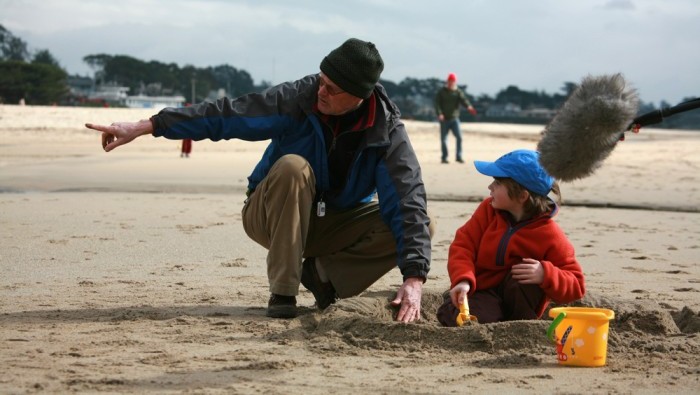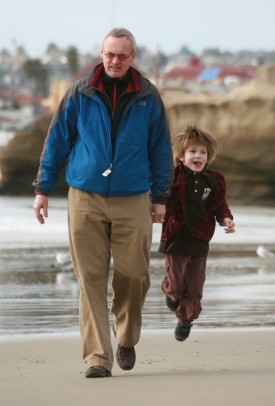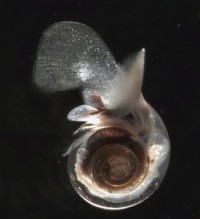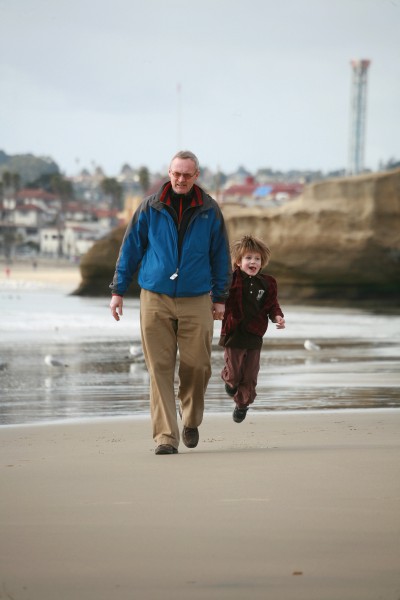 Sven Huseby and his grandson Elias during production of the film A Sea Change.Photo: Daniel de La Calle
Sven Huseby and his grandson Elias during production of the film A Sea Change.Photo: Daniel de La Calle
If you’ve ever doubted the power of the printed word, strike up a conversation with one Sven Huseby, whose entire life was changed by one article in the New Yorker.
The retired history teacher found himself one day reading Elizabeth Kolbert’s “The Darkening Sea” and the next traveling all over the world in search of answers about ocean acidification — with a documentary film crew tailing him all the way. The result is A Sea Change, a film about the largely underreported effects of excess carbon dioxide on the chemistry of our sensitive seas.
One reviewer has called it a “global warming horror documentary.” And there is certainly plenty to fear as Huseby — and the audience — learns more and more about the threat of ocean acidification. He interviews scientists who tell him 118 billion metric tons (or 118 billion VW Bugs worth) of CO2 have already been absorbed by the ocean. He watches the enamel of a human tooth quickly dissolve after sitting in a cupful of carbonated water. He listens during a conference where scientists ask each other how they missed this big issue — and whether we’re already screwed (answer: probably).
 Huseby and his trusty sidekick.Photo: Daniel de La CalleBut despite all this, A Sea Change emerges as more love story than horror flick. For one, the film is centered around Huseby’s relationship with his (almost unbearably adorable) grandson, Elias, who serves as both sidekick-style comic relief and helpful narrative device as Huseby reports on the progress of his quest. The gap-toothed five-year-old is incredibly precocious and knowledgeable about the ocean environment (“no, it’s a lungfish!” he says, pointing to a drawing he’s made in the sand) — perhaps it’s an inherited trait.
Huseby and his trusty sidekick.Photo: Daniel de La CalleBut despite all this, A Sea Change emerges as more love story than horror flick. For one, the film is centered around Huseby’s relationship with his (almost unbearably adorable) grandson, Elias, who serves as both sidekick-style comic relief and helpful narrative device as Huseby reports on the progress of his quest. The gap-toothed five-year-old is incredibly precocious and knowledgeable about the ocean environment (“no, it’s a lungfish!” he says, pointing to a drawing he’s made in the sand) — perhaps it’s an inherited trait.
A competing love story also develops as Huseby begins to learn about pteropods, a type of planktonic snail about the size of a lentil. They’re known as “sea butterflies” because of the wing-like appendages that help propel them through the water, but the name is also apt to describe their frailty: the organism’s thin, colorless shell disintegrates with the dip in pH associated with excess CO2.
They play a starring role in Kolbert’s article and consequently become a sort of mild obsession for Huseby, who’s shown Googling image after image of the transparent sea creature and cooing when he sees them alive for the first time in a lab. He’s even planning to produce a children’s book about them. But Huseby’s crush isn’t unwarranted: The humble pteropod serves as food for a large variety of fish who become meals for larger fish as well as birds and mammals (and us!), making them vital to the marine food chain.
 A pteropod.Photo: NOAAThe pteropod isn’t the only organism that will be affected by the increasing acidity of the ocean, though. Anything with a calcium carbonate-based skeleton or shell will have trouble making and maintaining those structures; these include corals, crustaceans like crabs, shrimp, and lobsters, and shellfish like oysters, clams, and mussels.
A pteropod.Photo: NOAAThe pteropod isn’t the only organism that will be affected by the increasing acidity of the ocean, though. Anything with a calcium carbonate-based skeleton or shell will have trouble making and maintaining those structures; these include corals, crustaceans like crabs, shrimp, and lobsters, and shellfish like oysters, clams, and mussels.
So what do we do about all this? Huseby goes there too — or rather he goes to Norway and to Silicon Valley and other places around the world where exciting advancements are being made in solar, wind, and geothermal energy generation. He talks to the entrepreneurs and investors who are putting wind in the sails of a carbon-free energy economy. He walks on the beach with a young environmental lawyer who helped in the court cases that led to the EPA’s determination that CO2 is a pollutant and should be regulated.
These scenes provide hope for what Huseby calls “our entrepreneurial opportunity, our chance to explore what’s possible.” And the conversations he had — and continues to have — with folks making bold moves in the right direction helped lift him out of the depressive state he appears to be in during some portions of the film.
And it’s a good thing, too, because Huseby is more energized than ever in his quest to publicize the dual threats of ocean acidification and global warming. During a panel discussion following a Seattle International Film Festival screening, Huseby announced that he’ll be attending the United Nations Climate Change Conference in Copenhagen this December and will be showing the film there. He’s also planning screenings for the National Oceanic and Atmospheric Administration (NOAA) and a UN delegation. He’s even been asked to testify on the topic in front of Congress.
“We have a 10-15 year window to make some noise,” he said. “I would love to see the term ‘ocean acidification’ become part of the political discourse.”
And thanks to this film — and Huseby’s love of the ocean — it just might.



